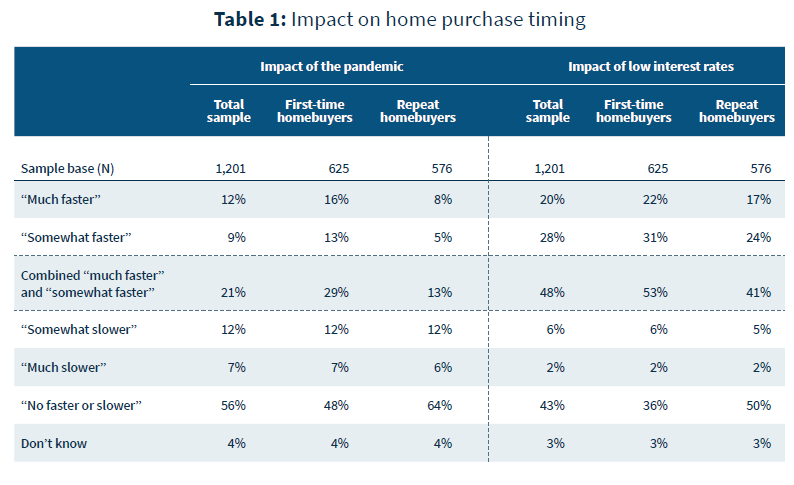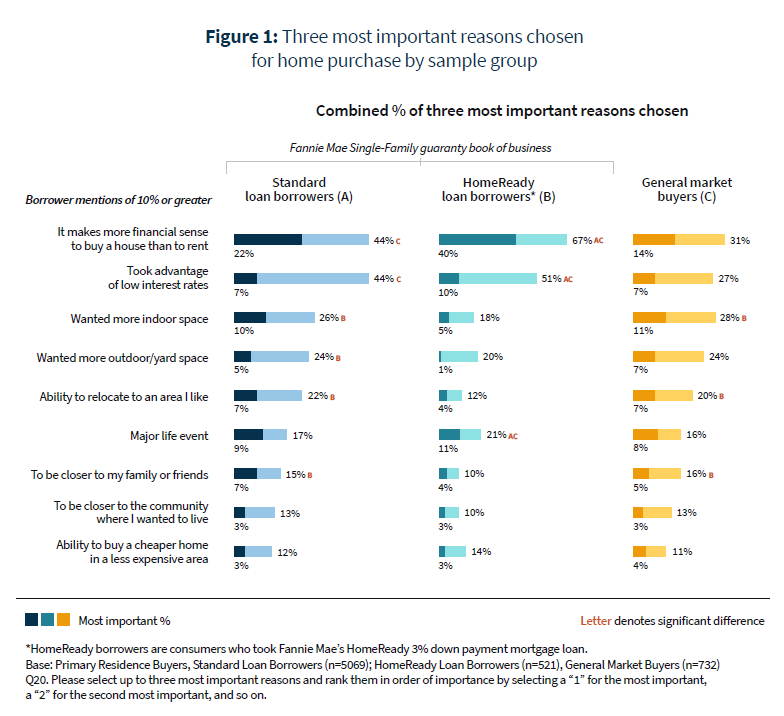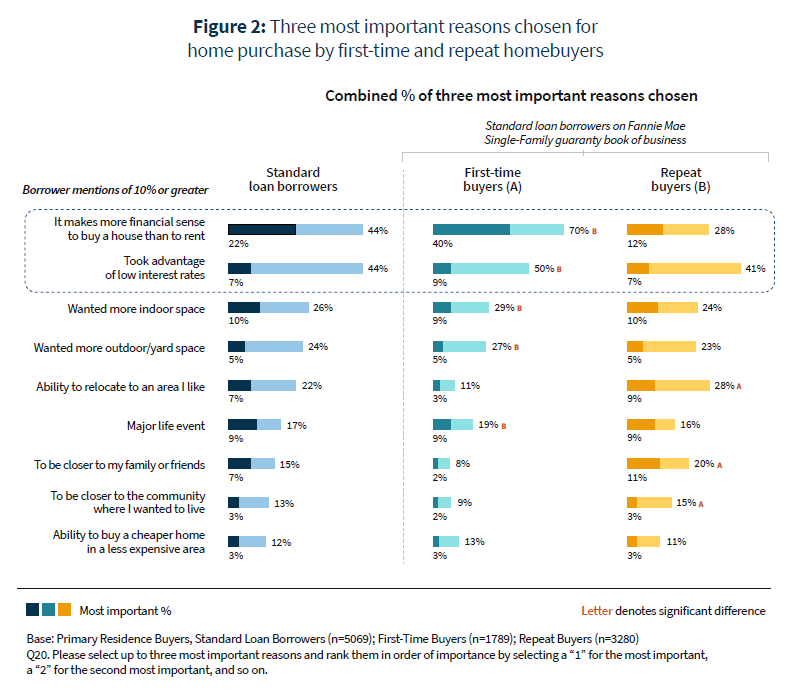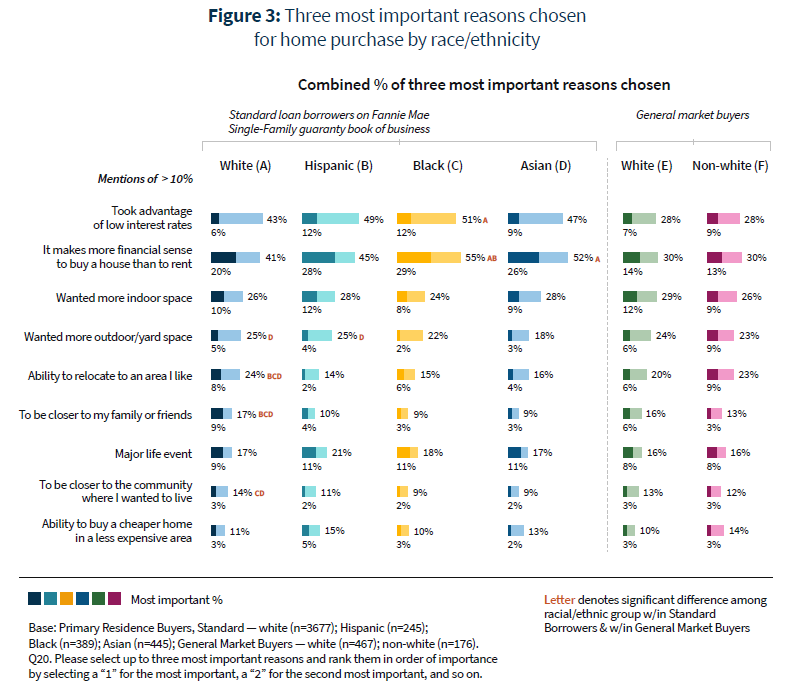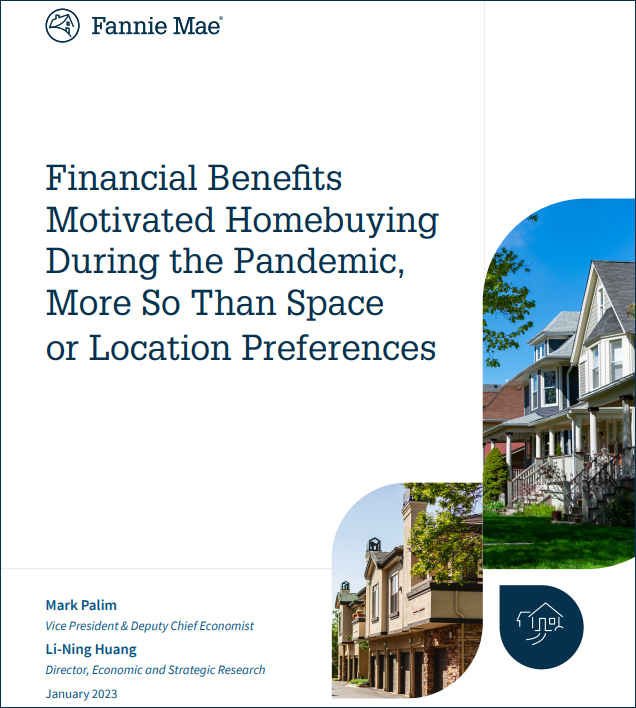Housing Insights: Financial Benefits Motivated Homebuying During the Pandemic, More So Than Space or Location Preferences
In recent discussions of our economic outlook, we have been asked multiple times why home sales dropped so sharply this past year given a pronounced preference shift among consumers during the pandemic toward single-family housing. Indeed, single-family housing was an unintended beneficiary of the pandemic and its associated policy response. During the pandemic, mortgage rates reached historically low levels, with the average 30-year fixed mortgage rate hovering around 3 percent though the end of 2021. Despite a low inventory-to-sales ratio during this time period by historical standards, as well as rising home prices, both home sales and purchase mortgage originations reached record highs in 2021.1 Anecdotal and analytical evidence suggest that the pandemic prompted people to move from smaller housing units in high-density city centers to larger homes in lower-density areas; and this was particularly true of first-time homebuyers.2 Overall, the rise in home sales was fueled by both first-time homebuyers and move-up buyers. In fact, demand was so strong that the median number of days that homes were on the market shortened from 74 in 2017 to 46 in 2021.3
We are now in a different phase of the economic and housing cycle. From the end of 2021 through September 2022, mortgage rates increased from 3 percent to over 7 percent. This rapid rate increase contributed to the pace of total home sales declining from an annualized pace of over 7 million units in January 2022 to approximately 5 million units in October 2022. Our latest forecast doesn't expect the annualized pace of total homes sales to exceed 5 million units again until 2024.
One outstanding question from the pandemic-related boom in home sales regards what actually drove purchase demand to increase so substantially. Were buyers motivated more by physical space or financial considerations, or was it a combination of both? In 2021, we conducted two survey studies among consumers who purchased a home for primary residence during the pandemic. The responses in those surveys help to explain why home sales declined in 2022 continue to inform our outlook for the years ahead.
Study #1 (Q1 2021)
First, we conducted a telephone survey in the first quarter of 2021 among homeowners in Fannie Mae's single-family guarantee book of business with primary-residence purchase mortgage loans originated in 2020. We asked respondents if they accelerated their home purchase due to the COVID-19 pandemic or because of low interest rates.
As shown in Table 1 below, 56% of respondents said the pandemic itself neither accelerated nor slowed their home purchase timeline. Among first-time homebuyers, 29% said it accelerated their home purchase decision, compared to only 13% of repeat homebuyers (often described as move-up buyers).
Click image above for larger view
In contrast, the impact of low interest rates on home-purchase timing was much stronger than the impact of the pandemic, especially among first-time homebuyers. As also shown in Table 1, 48% of homebuyers said they accelerated their home purchase because of low interest rates, compared to 21% saying they did so because of the pandemic. Among first-time homebuyers, 53% said they navigated the homebuying process faster because of low interest rates, compared to 29% saying they did so because of the pandemic.
Study #2 (Q4 2021)
In October 20214, we conducted an online large-scale survey of two populations:
- Borrowers from Fannie Mae's Single-Family Guaranty Book of Business with loans originated between July 2020 and August 2021 on a primary residence (i.e., not for second home or investment property purchases).5
For this sample, two different subsamples were pulled: (1) standard eligibility, non-HomeReady® borrowers; and (2) HomeReady borrowers (HomeReady is Fannie Mae's 3% down payment mortgage product designed to help lower-income families gain access to mortgage credit).6
- Consumers from a large third-party panel who self-reported purchasing a primary residence using a mortgage from July 2020 to September 2021. This group is referred to below as "General Market Buyers." This sample includes homebuyers who could have any type of mortgage loan, including a government loan7, unlike the first sample whose loans were originated to Fannie Mae's eligibility standards.
Table 2 below shows the sample composition with survey respondent sizes8:
Click image above for larger view
In the survey, we presented a list of possible homebuying reasons and asked respondents to select and rank their three most important reasons.
As Figure 1 shows, the key motivator for consumers to purchase a home during the pandemic was to meet a financial objective, such as believing that it makes more financial sense to own than to rent or taking advantage of low interest rates. The latter was particularly true for HomeReady Borrowers, many of whom have 3% down-payment mortgages. Taking advantage of low interest rates, of course, is a more time-sensitive motivator because of its dependence on often-quickly-moving market conditions. The belief that "it makes more financial sense to buy a house than to rent" was cited most frequently across sample groups as the most important reason for purchasing a home. The desire for more indoor or outdoor/yard space, presumably stemming in part from pandemic-driven social behavior and preference shifts, was a secondary driver for homebuying. These findings are consistent with those from the telephone survey conducted in Q1 2021, referenced above.
However, we found less differentiation but a similar rank order between financial- and space-related reasons among General Market Buyers. This could be because the General Market Buyers sample is somewhat more demographically distinct from the Fannie Mae book sample; for example, a larger share of the General Market Buyers sample reported being younger, living with adult children and parents, and residing in self-described urban areas. These differences could indicate that space needs for this group are of higher priority. They also reported having more varied mortgage loan types, with a large share saying they have a government loan.7,8
The topic of home-purchase mobility came up frequently during the pandemic. Some analysts noted that people moved from high-density city centers to lower-density areas because of the pandemic.2 Some also suggested that the flexibility of remote work allowed people to relocate to areas they preferred for particular amenities or other reasons, such as lower housing costs. However, our survey findings overall show location-related motivations as weaker than the financial- and space-related motivations, at least among homebuyers. As Figure 1 shows, the "change location" preference was not a prominent purchase motivator.
Click image above for larger view
Figure 2 presents the results comparing first-time and repeat homebuyers among Fannie Mae standard eligibility borrowers. As shown, the finding remained the same. Financial benefits drove homebuying for both first-time and repeat homebuyers, and much more so for first-time homebuyers. First-time homebuyers exhibited a much stronger belief that owning made more financial sense than renting.
In comparing first-time and repeat homebuyers, we also observed some life-stage differences. First-time homebuyers (who tend to be younger than repeat homebuyers) were more likely to say they want to have more indoor or outdoor space, while repeat homebuyers were more likely to relocate to be closer to families or to an area they like.
Click image above for larger view
Figure 3 presents the results comparing race/ethnicity groups. Financial benefits again were the primary motivation for home-purchase motivations across race/ethnicity groups. Black and Asian homebuyers in Fannie Mae's guarantee book of business exhibited a stronger belief that owning makes more financial sense than renting, which was also cited most frequently as the most important homebuying reason across race/ethnicity groups.
Click image above for larger view
Discussion
The survey findings illustrate the primacy of financial considerations over the benefits of physical space in influencing homebuying behavior during the pandemic. Consistent with our research prior to the pandemic, the general public's belief that "owning makes more financial sense than renting" remains a major motivational driver for homeownership.9 Additionally, over the past decade, our tracking research has shown that most Americans consistently see homeownership as a safe investment with high potential.10
Findings from both surveys also provide evidence that location was a weaker motivational factor for pandemic-period homebuying. Comparing the top home purchase reasons showed clearly that financial considerations outweighed location as the more immediate driver for buying a home in 2020 and 2021. As the path of home sales over the past two years shows, consumers' ability to act on favorable attitudes about homeownership depends largely on having the necessary financial resources; and low interest rates and a strong economy during the pandemic recovery period provided a favorable environment for home purchase activity. We currently forecast that existing home sales will remain at a relatively low level until some combination of lower home prices or lower interest rates help reverse the deterioration in affordability that, as of this writing, has made homeownership more unaffordable than at any point in the past 20 years.
To access the research paper in PDF form, click here.
Opinions, analyses, estimates, forecasts, and other views of Fannie Mae's Economic & Strategic Research (ESR) Group or survey respondents included in these materials should not be construed as indicating Fannie Mae's business prospects or expected results, are based on a number of assumptions, and are subject to change without notice. How this information affects Fannie Mae will depend on many factors. Although the ESR Group bases its opinions, analyses, estimates, forecasts, and other views on information it considers reliable, it does not guarantee that the information provided in these materials is accurate, current, or suitable for any particular purpose. Changes in the assumptions or the information underlying these views could produce materially different results. The analyses, opinions, estimates, forecasts, and other views published by the ESR Group or survey respondents represent the views of that group as of the date indicated and do not necessarily represent the views of Fannie Mae or its management.
1 The mortgage industry in 2021 had $4.6 trillion in mortgage originations, outpacing 2020's prior record high of $4.3 trillion, with purchase lending ending the year at $1.9 trillion, the highest level on record. ESR October Housing Forecast
Fannie Mae provided about $1.36 trillion in liquidity to the single-family mortgage market in 2021, with $451 billion for purchase lending which is higher than $411 billion in 2020 and $313 billion in 2019.
Fannie Mae 2021 10K
Fannie Mae 2020 10K
Fannie Mae 2019 10K
2 Rebecca Meeker and Nuno Mota, Housing Insights, "COVID-19 Led First-Time Homebuyers to Move Away from Highly Dense City Centers," March 30, 2021.
3 Housing Inventory: Median Days on Market in the United States, https://fred.stlouisfed.org/series/MEDDAYONMARUS#0
4 The online survey was conducted from October 19, 2021 to November 1, 2021.
5 The survey is anonymous. In addition, Fannie Mae commissioned a third-party research supplier to collect and analyze data at aggregate to ensure confidentiality of survey responses.
6 A stratified sampling scheme based on Loan-to-Home Value (LTV) ratio, Debt-to-Income (DTI) ratio, and FICO score ranges was used separately in pulling each Fannie Mae borrower subsample. For each subsample, survey responses collected were then weighted based on LTV ratio, DTI ratio, and FICO score ranges to ensure that the survey respondent sample well represented the target population group.
7 Among the sample of "General Market Buyers," about 56% respondents self-reported having a government loan vs. 44% not.
8 An analysis comparing demographics between these two sample sources shows that Fannie Mae borrowers (including HomeReady® borrowers) tend to be older than General Market Buyers. Fannie Mae standard eligibility borrowers also appear to have higher income and more education than General Market Buyers.
9 The consumer belief that it makes more financial sense to own than to rent has consistently been found via the National Housing Survey®, a monthly telephone survey among 1,000 adults to track American consumers' financial and housing attitudes. In the 1990s, about 80%-90% of consumers surveyed (depending on the year) believed that one is "better off owning rather than renting." From 2010 to 2019, consistently, about 85% of consumer surveyed every month say "owning makes more sense because you're protected against rent increases and owning is a good investment over the long term." The trend is fairly stable even during 2018 when interest rates rose.
"What Drives Consumers' Intentions to Own or Rent?" Fannie Mae, August 2012.
This study shows that the belief of owning or renting makes more sense financially is the most important factor predicting people's buy or rent decision for their next move, besides demographics (e.g., age, income, and marital status).
10 "Consumers Continue to See Homes as a Safe, High Potential Investment," Fannie Mae, Q4 2020

